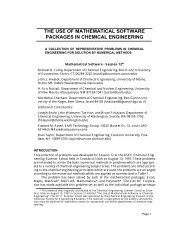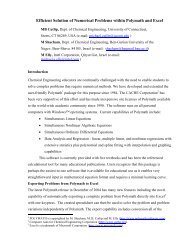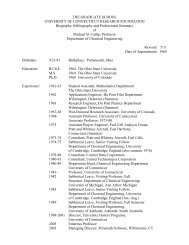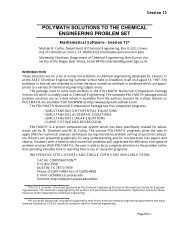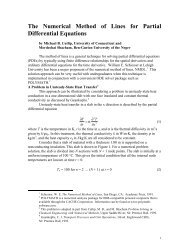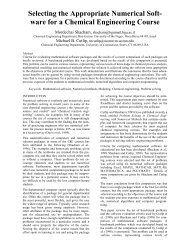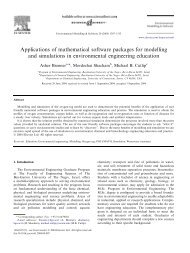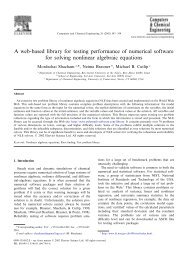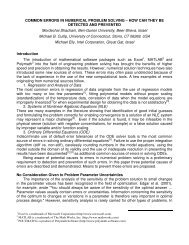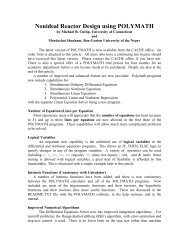Maple Solutions to the Chemical Engineering Problem Set
Maple Solutions to the Chemical Engineering Problem Set
Maple Solutions to the Chemical Engineering Problem Set
Create successful ePaper yourself
Turn your PDF publications into a flip-book with our unique Google optimized e-Paper software.
%1 72 P 2 ab 36 PaRT 8P 3 b 3<br />
24 P 2 b 2 RT 24 R 2 T 2 Pb 8R 3 T 3<br />
12 12 P 5 ab 4 := − + + + + + (<br />
24 P 4 a 2 b 2<br />
12 P 3 a 3<br />
60 P 3 a 2 RTb 3P 2 a 2 R 2 T 2<br />
36 P 4 ab 3 RT 36 P 3 ab 2 R 2 T 2<br />
+ + − − + +<br />
12 P 2 abR 3 T 3<br />
1 / 2<br />
+ )<br />
1<br />
− − −<br />
3<br />
%2 :=<br />
Pa<br />
1<br />
9 P2 b 2 2 1<br />
PbRT<br />
9 9 R2 T 2<br />
%1 / 1 3<br />
Note that <strong>the</strong>re are three solutions (as we should have anticipated since <strong>the</strong> polynomial is a cubic).<br />
The o<strong>the</strong>r two solutions include <strong>the</strong> term I (<strong>the</strong> square root of -1). However, this does not mean<br />
that <strong>the</strong> o<strong>the</strong>r two roots are complex. Under certain conditions all three roots are real and under<br />
o<strong>the</strong>r conditions only one root is real as we shall demonstrate below.<br />
It is worth noting here that even though explicit analytical expressions for <strong>the</strong> roots may be<br />
obtained, <strong>the</strong>se formulae are rarely used in engineering computations and iterative methods are<br />
employed instead. The reason is that <strong>the</strong>rmodynamic computations often involve <strong>the</strong> repeated<br />
evaluation of <strong>the</strong> compressibility under slightly varying conditions and under <strong>the</strong>se circumstances it<br />
proves <strong>to</strong> be more efficient (from a computational perspective) <strong>to</strong> use an iterative method. We shall<br />
illustrate <strong>the</strong> use of iterative methods in later examples.<br />
Dimensionless (Reduced) form of <strong>the</strong> Equation of State<br />
It is sometimes useful <strong>to</strong> represent <strong>the</strong>rmodynamic functions in terms of so-called reduced<br />
properties. The reduced pressure, volume and temperature are defined as follows:<br />
> Prdef := P[r]=P/P[c]: Vrdef := v[r]=v/v[c]: Trdef := T[r]=T/T[c]: Prdef, Vrdef, Trdef;<br />
P v T<br />
P = , v = ,<br />
T =<br />
r P r v r T<br />
c c c<br />
The critcial compressibility is, <strong>the</strong>refore, defined by<br />
> zcrit := Subs(State(c),z=z[c],zdef): zcrit;<br />
P v<br />
c c<br />
z =<br />
c RT<br />
c<br />
For <strong>the</strong> VDW EOS this has a special value<br />
> Subs(EOSParams[VDW],zcrit);<br />
3<br />
z =<br />
c 8<br />
suggesting that all fluids have <strong>the</strong> same critical compressibility with a value of 0.375. In fact, <strong>the</strong><br />
critical compressibilities of a great many fluids have almost <strong>the</strong> same value. However, that value is<br />
closer <strong>to</strong> 0.25. This means that <strong>the</strong> VDW EOS will not be all that succesful at predicting densities<br />
in <strong>the</strong> critical region even though it does provide a qualitatively accurate model of <strong>the</strong> PVT<br />
behavior of many real fluids.<br />
In what follows we use <strong>the</strong> above definitions of <strong>the</strong> reduced properties <strong>to</strong> rewrite <strong>the</strong> VDW EOS in<br />
Page 4



